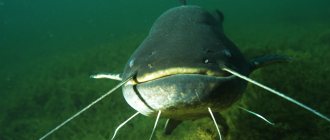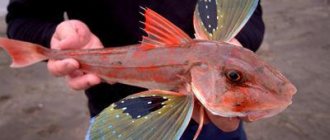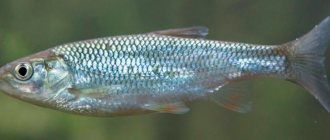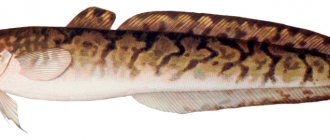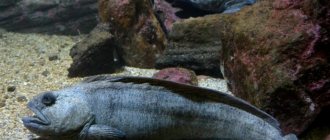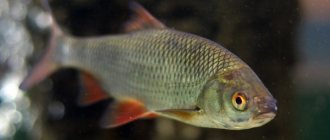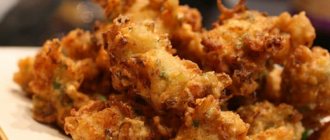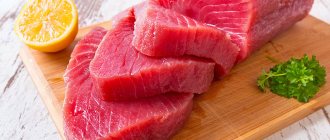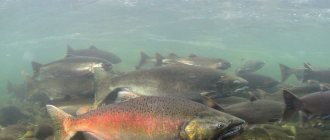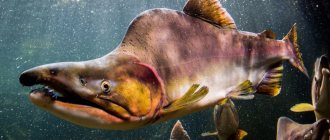When choosing canned fish in the store, many housewives ask the question: what kind of fish is the European sardine and how does it differ from sardinella? Let's find out what the difference is and which fish to give preference to.
What do you cook with sardines?
- Main courses 46%, 17 votes
17 votes 46%17 votes - 46% of all votes
- Soups 43%, 16 votes
16 votes 43%
16 votes - 43% of all votes
- Pies 11%, 4 votes
4 votes 11%
4 votes - 11% of all votes
Total votes: 37
18.04.2020
- Main courses 46%, 17 votes
17 votes 46%17 votes - 46% of all votes
- Soups 43%, 16 votes
16 votes 43%
16 votes - 43% of all votes
- Pies 11%, 4 votes
4 votes 11%
4 votes - 11% of all votes
Total votes: 37
18.04.2020
×
You or from your IP have already voted.
What kind of fish is a sardine?
Sardines are small fatty fish of the herring family that live in the Mediterranean Sea and the Atlantic Ocean. The name is collective and combines three genders:
- Pilchards;
- Sardinops;
- Sardinella.
The body of the fish has a streamlined cylindrical shape, its length on average does not exceed 20 cm. The color is silver, and in the spinal part it is green with a bluish tint (see photo).
Individuals of the sardina species gather in large schools and live in warm coastal waters, not descending to a depth of more than 100 m, which is used by fishermen. Several tons of fish can get into the fishing net at a time.
The value of herring fish species lies in the record content of nutrients with an average calorie content. They contain fatty acids, vitamins, and microelements in an easily digestible form.
Atlantic sardines have a milder taste than European ones, but only a true gourmet can notice the differences.
There is no fundamental difference between sardine and sardinella. Any of its three subspecies may appear in canned food under the collective name, and if the label says “sardinella,” then that is what is in the can.
Natural enemies of Iwasi
Photo: What Iwasi looks like
Mass migrations of iwasi attract all predatory fish and mammals. And trying to escape from large predators, Far Eastern sardines rise to the surface, becoming easy prey for birds. Seagulls circle over the water for a long time, tracking and observing the behavior of fish. Partially immersed in the water, the bird easily catches the unfortunate fish.
Ivasi is a favorite treat for:
- whales;
- dolphins;
- sharks;
- tuna;
- cod;
- seagulls and other coastal birds.
The Far Eastern sardine is simply a storehouse of useful substances and components for humans, not having a high cost, it is considered the most healthy and tasty. Therefore, the main threat, as for many fish, remains fishing.
Iwashi has been the main commercial fish for many decades. Since the 1920s, the entire coastal fishery has been focused on catching sardines. The catch was carried out using nets, which contributed to the rapid decline of this species.
Interesting fact: As a result of scientific research, scientists have confirmed that this type of fish can be used for health purposes, in particular the prevention and treatment of cardiovascular diseases.
Benefits and harms
Sardine is a source of iodine - this is especially important for people living far from the sea and experiencing iodine deficiency. The fish also contains the following beneficial compounds:
- Vitamins - D, B4, B5, B6, B12, PP;
- Minerals – selenium, zinc, iron, sodium, chromium, phosphorus, cobalt, copper;
- Omega-3 and Omega-6 acids.
100 g of boiled fish fillet contains 150 kcal (when preserved in oil, the calorie content increases to 220 kcal) and 27% protein, so sardines are recommended for dietary, baby and sports nutrition.
Sardine fish, when eaten regularly, has a beneficial effect on the body:
- Thins the blood, strengthens blood vessels;
- Helps convert glucose into energy and reduce bad cholesterol levels;
- Accelerates tissue regeneration;
- Reduces the severity of inflammatory processes;
- Calms the nervous system, strengthens memory;
- Reduces the risk of developing cancer.
Doctors and nutritionists advise including sardines in the diet to prevent hypertension, atherosclerosis, leukemia, cancer, and diabetes.
Just 2 servings of sardines per week contribute to weight loss and activation of the natural production of collagen and elastin. This means that sea fish is the best assistant in preserving beauty and youth.
Do you like fish soup?
- Yes 88%, 68 votes
68 votes 88%68 votes - 88% of all votes
- No 12%, 9 votes
9 votes 12%
9 votes - 12% of all votes
Total votes: 77
23.09.2019
- Yes 88%, 68 votes
68 votes 88%68 votes - 88% of all votes
- No 12%, 9 votes
9 votes 12%
9 votes - 12% of all votes
Total votes: 77
23.09.2019
×
You or from your IP have already voted.
The possible harm of a canned product is the increased salt content, which causes swelling, and the likelihood of individual allergic reactions.
Beneficial features
Fish contains easily digestible protein. The body spends a minimum of time/energy absorbing the product, but receives long-term saturation, high nutritional value and a whole range of beneficial properties. Sardine is the record holder for phosphorus (P) and cobalt (Co) content.
Cobalt
Cobalt regulates the level of red blood cells in the blood, strengthens the walls of blood vessels, creates additional protection for the heart, and regulates the level of thyroid hormones. In addition, if there is a lack of cobalt, the body experiences “cobalt pneumonia.”
Phosphorus
Phosphorus strengthens bone tissue and helps form a high-quality muscle corset. The nutrient accumulates energy in the human body by participating in the synthesis of proteins, fats and carbohydrates. The element increases the level of absorption of other vitamins and minerals: the body works less, but receives twice as many useful components. Phosphorus also affects the condition of bones, teeth, hormonal levels and chemical reactions in the body.
Vitamin D
The nutrient is responsible for the absorption of calcium and phosphorus, stimulating phosphorus-calcium metabolism, preventing the development of rickets and osteoporosis. The best natural source of vitamin D is sunlight. Given the specifics of the climate, the vitamin is available to us only in the spring and summer. During the cold season, the body has to wait for outside help. The sardine should be such a help. The content of “sunshine vitamin” in fish is 1500 IU per 100 g.
Omega-3
Another important component of sardines is polyunsaturated fatty acids. All of humanity knows about the properties of Omega-3: we force ourselves and our children to drink fish oil, take blister tablets, and various dietary supplements. But plant components are always better than chemical ones due to their composition, percentage of digestibility and benefits. 1 spoon of fish oil is inferior to fresh ocean fish not only in quality, but also in taste. Look for a healthy, and most importantly, enjoyable alternative to satisfy not only the body’s needs, but also food receptors.
Omega-3 is a kind of prevention of blood clots. The component prevents pathologies of the heart and blood vessels, improves blood flow into the capillaries and fills the body with energy. As a result, we get beautiful skin, a well-functioning gastrointestinal tract, a healthy heart and, most importantly, a healthy mind.
What else is good about sardines:
- minimizes the manifestations of psoriasis and other skin pathologies;
- improves vision, nourishes and supports the functioning of the retina;
- stimulates brain activity;
- has an antioxidant effect;
- strengthens the protective function of the immune system;
- prevents the development of asthma.
Mimosa salad with sardine
There are several recipes for the famous salad, but the classic is the version with rice. For one serving you need:
- Sardine in oil 40 g;
- Boiled rice – 40 g;
- Boiled egg - 1 pc.;
- Carrot var. and fresh onions – 40 g each;
- Vinegar 6% - 1 tsp;
- Water - 1 tbsp. l.;
- Salt and mayonnaise - to taste.
Preparation: chop the canned food, grate the carrots, chop the onion with a knife and soak for 10 minutes in a mixture of water and vinegar.
Peel the egg, separate the yolk from the white and grate separately. The salad is collected in layers, coated with mayonnaise a couple of times for juiciness. Layer order: rice, fish, onion, carrot, white, yolk. It is advisable to let the dish sit in the refrigerator for a couple of hours, and before serving, garnish with herbs, as in the photo.
Calorie content
Interestingly, it differs in the habitat of the fish. For example, those caught in the Pacific Ocean contain 170 Kcal, and those from the Atlantic - 250 Kcal. It turns out that the latter is “fatter”.
The calorie content of the finished fish differs (100 grams are taken into account):
- • boiled – 178 Kcal;
- • fresh – 169 Kcal;
- • in tomato – 160 Kcal;
- • in oil – 230 Kcal.
The indicators are small, so it is often used by people losing weight and those on a therapeutic diet.
Canned sardine
Prices for canned fish in stores are steadily rising, but you can save money by preparing it yourself - no one will notice the difference from the industrial product! Products per minimum serving (200 g):
- Fish (headless, cut into pieces) - 170 g;
- Onion 20 g;
- Vegetable oil – 10 ml;
- Citric acid and salt on the tip of a knife;
- Bay leaf – 1 pc.;
- Peppercorns – 2-3 pcs.;
- Spices if desired;
- 0.5 glasses of water.
Salt the fish and let it sit for a couple of hours. Cut the onion into half rings, place on the bottom of a small saucepan, place the sardine on top, add water with citric acid dissolved in it. Next, send the pepper and bay leaves. Pour in the oil.
Cover the container with a tight lid and place in an oven preheated to 150 degrees for 2 hours. The product is ready for use; for long-term storage it must be sealed in a sterilized glass jar of a suitable size.
general characteristics
Sardine is a commercial marine fish. It often lives far from the coast, but during spawning, schools of sardines, which can reach about 5 million individuals, approach the coastline at a distance of about 25-30 meters. The designated herring representatives differ from their relatives in a few ways, but there are certain differences. For example, its gill cover has grooved stripes and a golden color, and its back is blue-greenish, but its belly is silvery-white.
Sardinella and sardine what is the difference
So how does one species differ from another? There is no significant difference in taste and nutritional value.
Sardinella lives exclusively in warm waters, and reaches larger sizes - up to 35 cm. Its body looks flatter and taller, the upper fin is located in the middle part of the back (in other species it is shifted to the head). She also has teeth, albeit small ones.
Chemical composition
Nutritional value (per 100 grams of ocean sardine)
| Calorie content | 166 kcal |
| Squirrels | 19 g |
| Fats | 10 g |
| Carbohydrates | 0 g |
| Alimentary fiber | 0 g |
| Water | 69.2 g |
| Ash | 1.8 g |
Vitamin composition (in milligrams per 100 grams of raw product)
| Retinol (A) | 0,01 |
| Thiamine (B1) | 0,01 |
| Riboflavin (B2) | 0,15 |
| Pantothenic acid (B5) | 1 |
| Pyridoxine (B6) | 0,7 |
| Folic acid (B9) | 0,0062 |
| Cobalamin (B12) | 0,011 |
| Ascorbic acid (C) | 1,13 |
| Tocopherol (E) | 0,48 |
| Biotin (N) | 0,00024 |
| Niacin (RR) | 4,04 |
Nutrient balance (in milligrams per 100 grams of raw product)
| Macronutrients | |
| Potassium (K) | 385 |
| Calcium (Ca) | 80 |
| Magnesium (Mg) | 40 |
| Sodium (Na) | 140 |
| Sulfur (S) | 200 |
| Phosphorus (P) | 280 |
| Chlorine (Cl) | 165 |
| Microelements | |
| Iron (Fe) | 2450 |
| Iodine (I) | 35 |
| Cobalt (Co) | 30 |
| Manganese (Mn) | 50 |
| Copper (Cu) | 185 |
| Molybdenum (Mo) | 4 |
| Nickel (Ni) | 8 |
| Fluorine (F) | 430 |
| Chromium (Cr) | 55 |
| Zinc (Zn) | 80 |
Types[edit]
| Commercially important species | ||||||||||||||
| Genus | Common name | Scientific name | Maximum. length | Type. length | Maximum. weight | Maximum. age years | Trophic level | Fish base | FAO | THIS | IUCN status | |||
| cm | V | cm | V | gram | ounce | |||||||||
| Sardine | European sardine | Sardina pilchardus (Wahlbaum, 1792) | 27,5 | 10,8 | 20,0 | 7.9 | 15 | 3,05 | [18] | [19] | [20] | [21] | ||
| Sardinops | South American sardine | Sardinops sagax (Jenyns, 1842) | 39,5 | 15,6 | 20,0 | 7.9 | 490 | 17 | 25 | 2,43 | [22] | [23] | [24] | [25] |
| Japanese sardine [note 1] | Sardinops melanostictus (Schlegel, 1846). | [27] | [28] | [29] | NE | |||||||||
| California sardine [note 1] | Sardinops caeruleus (Girard, 1854) | [30] | [31] | [32] | NE | |||||||||
| South African sardine [note 1] | Sardinops ocellatus (Pappe, 1854). | [33] | [34] | [35] | NE | |||||||||
| Sardinella | Bali sardinella | Lemuru sardinella (Bleeker, 1853) | 23 | 9.1 | 20 | 7.9 | [36] | [37] | [38] | [39] | ||||
| Brazilian sardinella | Sardinella brasiliensis (Steindachner, 1879). | 3.10 | [40] | [41] | [42] | [43] | ||||||||
| Japanese sardinella | Sardinella zunasi (Bleecker, 1854) | 3,12 | [44] | [45] | [46] | [47] | ||||||||
| Indian oil sardine | Sardinella longiceps (Valenciennes, 1847) | 2.41 | [48] | [49] | [50] | [51] | ||||||||
| Golden sardinella | Sardinella gibbosa (Bleeker, 1849) | 2,85 | [52] | [53] | [54] | [55] | ||||||||
| Round sardinella | Sardinella aureus (Valenciennes, 1847) | 3,40 | [56] | [57] | [58] | [59] | ||||||||
| Madeiran sardinella | Sardinella maderensis (Lowe, 1839) | 3.20 | [60] | [61] | [62] | [63] | ||||||||
| Dussumieria | Rainbow sardine | Dussumieria acuta (Valenciennes, 1847) | 20 | 7.9 | 3,40 | [64] | [65] | [66] | [67] | |||||
- ^ B b c There are four different stocks in the genus Sardinops
, widely separated geographically.
FAO treats these stocks as separate species, while FishBase treats them as a single species, Sardinops sagax
. [26]
- European sardine, Sardina pilchardus
- In the 1980s, the South American sardine, Sardinops sagax
, was the most heavily fished sardine species. Some major stocks fell sharply in the 1990s (see chart below).
- Pacific sardine, Sardinops caerulea
How to cook
When buying fresh sardines, you need to properly prepare the fish before preparing dishes from it. Initially, you will need to clean it of scales. To do this, rub your fingers back and forth over the carcass under running water. Then remove the insides and rinse the cut belly of the sardine well. Further, the preparation process depends on the type of dish that will be prepared. For example, when salting, you can simply leave the fish whole or cut it into pieces. If you plan to prepare a salad or use it for sandwiches, then you should definitely remove the seeds.
